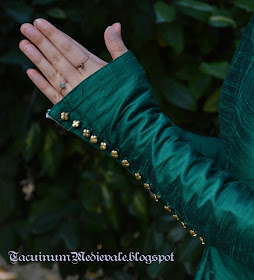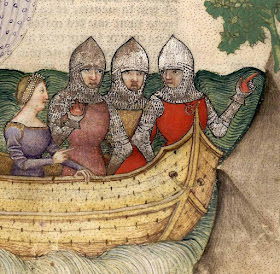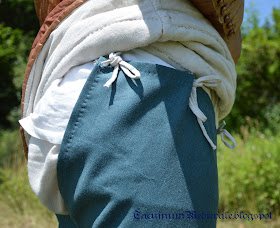 |
| La mia prima Herjolfsnes Challenge: il cappuccio Nørlund 78 – D10606 / My first Herjolfsnes challenge: the hood Nørlund 78 – D10606. |
Le sfide collettive mi piacciono particolarmente: durante la Manuscript Challenge, ho avuto la conferma che condividere i progressi del mio lavoro e allo stesso tempo seguire il processo creativo degli altri partecipanti è non solo un ottima occasione per imparare qualcosa di nuovo e migliorarsi, ma anche per lavorare con più entusiasmo sul progetto. Per questo, non ho esitato a partecipare alla nuova “sfida”, lanciata questa volta da Elina di Neulakko, la “Herjolfsnes challenge”
 |
| Piccoli cappucci erabo usati dalle donne anche in Italia. / Small hoods wereused by women in Italy too. 351v, part Latin 757 Missale et horae ad usum Fratrum Minorum. |
Lo scopo di questa sfida è riprodurre con un grado piuttosto alto di fedeltà uno dei reperti medievali rinvenuti in Groenlandia, uti
lizzando come fonti principalmente “Woven into the Earth” di Else Østergård (che ho recensito qui nel lontano 2013) e “Medieval Garments Reconstructed”, un libro realizzato dalla stessa autrice, che contiene gli schemi dettagliati con le misure dei reperti.
Per scaldare un po’ i muscoli prima di intraprendere un progetto più ambizioso, ho deciso di iniziare con un cappuccio, e ho scelto il Nørlund 78 – D10606. Il mio obiettivo, per questa sfida, era rispettare tutte le caratteristiche costruttive del reperto, cercando di aderire il più possibile alle forme e alle misure originali e di utilizzare i tipi di cucitura documentati dai reperti: rispetto all’opera di rievocatori e rievocatrici esperte, che si ripropongono di iniziare la sfida partendo dalla selezione della lana per poi procedere alla filatura e alla tessitura, il mio obiettivo è ben più modesto.
 |
| La mia stoffa, twill 2/2. / My fabric, 2/2 twill. |
I really enjoy group challenges: during the Manuscript Challenge, I had the confirmation that sharing the progress of my work and at the same time following other participants creative process is not only a great occasion to learn something new and improving my skills, but also a good way to gain more enthusiasm for my project. Therefore, I didn’t hesitate to join a new challenge, introduced by Elina from Neulakko, the “Herjolfsnes challenge” . The goal is to reproduce one of the original garments from Greenland with a good level of accuracy, using as main sources “Woven into the Earth” by Else Østergård (you can check out my review from 2013 here but it’s only in Italian) and “Medieval Garments Reconstructed”, its twin, that features schemes, patterns and detailed measures of the garments.
To warm up a bit before starting with a more ambitious project, I decided to begin with a hood, and I chose Nørlund 78 – D10606. My goal, for this challenge, was to respect all the features of the original find, matching as much as possible its shapes and measures and using the same seams: comparing it to the projects of skillful re-enactors, that are going to start their challenges from the selection of wool, to spin it and weave it, my goal is very humble.
 |
| Il disegno originale a matita, le alterazioni con gli spilli. The original pattern drawn with pencil, alterations with pins. |
Ho iniziato riproducendo su stoffa il cappuccio nelle dimensioni originali fornite da “Medieval Garments Reconstructed” (MGR), e ho dovuto apportare qualche modifica:
1 - ho ridotto l’apertura del viso di un paio di centimetri, perché era troppo largo per me
2 - ho rimpicciolito la parte posteriore in modo che fosse più stondato e più aderente alla testa: anche il reperto sembra avere questa forma
3 - ho aggiunto 4 centimetri alla lunghezza della parte frontale della foggia, sotto il collo, per essere sicura che il cappuccio coprisse la scollatura del mio vestito blu
4 - ho eliminato la punta prominente della foggia perché risultava troppo larga per me sulle spalle.
Ho mantenuto invece la forma del cappuccio al centro della testa, in particolare la forma a “corno” della parte frontale, che si nota in gran parte dei reperti, l’ampiezza molto ridotta dell cappuccio sulle spalle (i due gheroni infatti sono solo 8,5 cm) e il collo molto aderente, nel quale riesco a passare grazie all’elasticità della stoffa.
First, I reproduced the pattern on some scrap fabric in its original dimensions as given by “Medieval Garments Reconstructed” (MGR), and I had to make a few alterations (check out the figure for a clearer explanation):
1- I reduced the face opening of 2 cm, because it was too large for me
2- I reduced the back part of the head and made it more rounded and more fitted to the head: also the original hood seems to have this shape.
3- I added 4 cm to the length of the shoulder part under the neck, to be sure the hood covers the neck of my blue dress
4- I deleted the protruding part under the neck, because this way it was too big for me on the shoulders.
I kept the shape of the top of the hood, expecially the “horn” in the front, since it’s typical of many finds, very narrow shoulders (the side gores are only 8,5 cm) and the fitted neck: I can pass through it thanks to the elasticity given by the twill.
 |
| Il cappuccio indossato: sicuramente apprezzate il mio maglione molto medievale! / The hood: I'm sure you appreciate my very medieval sweater! |
Il reperto originale è di vadmal, una stoffa di lana prodotta in Groenlandia, con trama a twill 2/2: la lana che ho utilizzato io è piuttosto diversa dall’originale, ma è comunque un twill 2/2. Il colore è rosa, e l’ho trovata a un mercatino: in totale, ne ho consumati 100 x 65 cm, facendo combaciare la direzione del twill dei gheroni e del cappuccio (ma commettendo il peccato veniale di orientare le diagonali del mio twill da in alto a sinistra a in basso a destra per chi guarda, ovvero nella direzione opposta a quella dei reperti). La coda, o “liripipium”, è costituita da 4 parti come nell’originale, ma il punto di giuntura è determinato dalla lunghezza della mia stoffa e non coincide: è lungo circa 70 cm e argo 5,5 cm, come l’originale.
Arrivata al momento di cucire, ho cercato di riprodurre in particolar modo le cuciture tipiche dei reperti della Groenlandia: per la prima volta ho anche usato il filo di lana, invece di quello di lino.
- Cuciture principali: punto indietro (anche sei nei reperti non è specificato e probabilmente si tratta di un punto diverso), i margini, di 8-9 mm, sono stati aperti e schiacciati poi fissati con il sottopunto, senza aggiunta di filo di riempimento (filler thread)
- Cuciture dei gheroni: dall’esterno con sottopunto, con i margini rifiniti all’interno con sottopunto
- Apertura del viso: ho rispettato le specifiche informazioni del reperto. L’orlo è di 7 mm, fermato da sottopunto, ed è rinforzato e decorato da due file di “stab stitch”. In molti reperti l’orlo intorno all’apertura del viso è rinforzato dalla presenza di uno o due fili di riempimento: io ne ho utilizzati due di lana tinta da me con un secondo bagno di robbia, il cui colore è molto simile a quello della stoffa.
- Finitura delle spalle: ho rispettato anche qui le caratteristiche del reperto, lasciando 9 mm di orlo, fissato da sottopunto, e completato da due file di “stab stitch”. Ho inserito anche qui due fili di riempimento, ma non è chiaro se nei reperti fossero presenti anche in questa posizione.
Per la prima volta mi sono resa conto della diffferenza tra “running stitch” (punto filza) e “stab stitch”, osservando anche il lavoro di altri partecipanti alla Herjolfsnes Challenge: li ho schematizzati nella figura, che dovrebbe essere più comprensibile della mia spiegazione. La caratteristica principale dello “stab stitch” dei reperti della Groenlandia è che l’ago si muove sempre in diagonale attraverso la stoffa, creando sul dritto e sul rovescio due file di “running stitch”, in cui tutti i punti si toccano. È una finitura secondo me molto bella esteticamente, e anche molto robusta.
 |
| Rifinitura dell'orlo con la prima serie di "stab stitch". / Finishing the hem with the first row of stab stitch. |
The original hood is made of vadmal, a typical Greenlandic wool fabric, woven in 2/2 twill: the woll I used is quite different from the original, but it’s still a 2/2 twill. It’s pink and I found it in a charity shop: I used 100 x 65 cm of it, matching the twill lines of the hood and the gores (but actually mistaking the direction of the twill, since my lines go from top left to bottom right for who watches, the opposite way than the finds). The liripipe is made in 4 pieces like the original, but they are joined according to the necessity of my fabric and doesn’t match the original, but it’s 70 cm long and 5,5 cm wide like the find.
When time for sewing came, I tried to reproduce the typical seams of the Greenland finds, and for the first time I used woolen thread instead of linen thread.
- Main seams: back stitch (it’s not explained in detail in the books, but probably a different stitch was used), the seam allowance is 8-9 mm and has been opened, pressed and folded with overcast stitches.
- Gores: they were sewn from the outside with hem stitch, the seam allowance is folded on one side with overcast stitches.
- Face opening: I respected the specific information about the find. The seam allowance is 7 mm, folded with overcast stitches and reinforced with 2 rows of stab stitches. In many finds the hem around the face is reinforced with filler threads, so I put 2 threads of pink wool, plant-dyed by me with a 2nd bath of madder whose color matches the fabric.
- Shoulder finishing: I respected the original features of the hood here as well, leaving a 9 mm seam allowance folded down with overcast stitches and 2 rows of stab stitches. I decided to put here as well 2 filler threads, but it’s not clear if they were used in this position in any of the finds.
For the first time I thought about the difference between “running stitch” and “stab stitch”, thanks to other partecipants’ work for the Challenge as well: I made a small scheme to show better. While stab stitching, the needle passes through the fabric in a diagonal line and makes 1 lines of running stitches on both sides of the fabric, because every stitch touches the next one. It’s a very good looking finishing, and very strong too.
 |
| Running stitch, stab stitch. |
Il cappuccio è stato un piccolo “svago” nelle intense settimane che hanno preceduto l’evento di ricostruzione storica “La Spezieria di Diotaiuti”, un progetto al quale lavoro insieme al mio gruppo Civitas Alidosiana da più di un anno: grazie allo studio degli originali quaderni di bottega dello speziale imolese Diotaiuti, abbiamo potuto ricostruire la sua bottega e la grande quantità di merci presenti. Potete trovare ulteriori informazioni e una ricca galleria fotografica sul nostro sito
Come vedete sono riuscita a completare il cappuccio in tempo per indossarlo durante l’evento!
The hood has been a small diversion in the intense weeks before the historical reconstrucion event “La Spezieria di Diotaiuti” (Diotaiuti’s apothecary shop), a project I’ve been working on together with my group Civitas Alidosiana for more than a year: thanks to the original books of accounts written by the apothecary Diotaiuti, who lived in Imola in the 14th century, we could reproduce his shop and the great amount of wares he sold. You can find more information and a lot of pictures on our website, also in English here.
As you can see, I managed to complete the hood in time for the event!












































